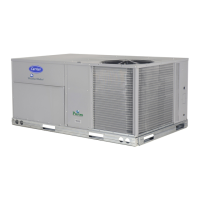7
PositioningonCurb—
Position unit on roof curb so that the following clearances
are maintained: 1/4 in. (6.4 mm) clearance between the
roof curb and the base rail inside the front and rear, 0.0 in.
clearance between the roof curb and the base rail inside on
the duct end of the unit. This will result in the distance
betwee n the roof curb and the base rail inside on the
condenser end of t he uni t being approximately equal to
Fig. 3, section C--C.
Although unit is weatherproof, guard against water from
higher level runoff and overhangs.
UNIT DAMAGE HAZARD
Failure to follow this caution may result in
equipment damage.
All panels must be in place when rigging. Unit is not
designed for handling by fork truck.
CAUTION
!
Flue vent discharge must have a mini mum horizontal
cle arance of 4 ft (1220 mm) from electric and gas meters,
gas regulators, and gas relief equipment. Minimum
distance between unit and other electrical ly live parts is
48 inches (1220 mm).
Flue gas can deteriorate building materials. Orient unit
such that flue gas will not affect building materials.
Locate mechanical draft system flue assembly at least 48
in. (1220 mm) from an adjacent building or combustible
material.
NOTE: Installation of accessory flue discharge deflector
kit will reduce the minimum clearance to combustible
material to 18 in. (460 mm).
After unit is in position, remove rigging skids and
shipping materials.
Step 7 — Convert to Horizontal and Connect
Ductwork (when required)
Unit is shipped in the vertical duct configuration. Unit
without factory--i nstalled economizer or return air smoke
detector option may be field--converted to horizontal
ducted configuration. To convert to horizontal
configuration, remove screws from side duct opening
covers and remove covers. Using the same screws, install
covers on vertical duct openings with the insulation--side
down. Seals around duct openings must be tight. See Fig.
6.
C06108
Fig. 6 -- Horizontal Conversion Panels
Field--supplied flanges should be attached to horizontal
duct openings and all ductwork should be secured to the
flanges. Insulate and weatherproof all external ductwork,
joints, and roof or building openings with counter flashing
and mastic in accordance with applicable codes.
Do not cover or obscure visibility to the unit’s informative
data plate when insulating horizontal ductwork.
Step 8 — Install Outside Air Hood
The outdoor hood components are shipped in a box
located in the unit return air compartment behind the
outdoor--ar opening access panel (or economizer). Access
is through the filter access panel. See Fig. 7.
1. To remove the existing unit filter access panel, raise
the panel and swing the bottom outward. The panel is
now disengaged from the track and can be removed.
2. To remove the component box from its shipping posi-
tion, remove the scre w holding the hood box bracket
to the top of the economizer. Slide the hood box out
of the unit. See Fig. 8.
FILTER ACCESS PANEL
OUTDOOR-AIR OPENING AND
INDOOR COIL ACCESS PANEL
COMPRESSOR
ACCESS PANEL
C06023
Fig. 7 -- T ypical Access Panel Locations
48TC

